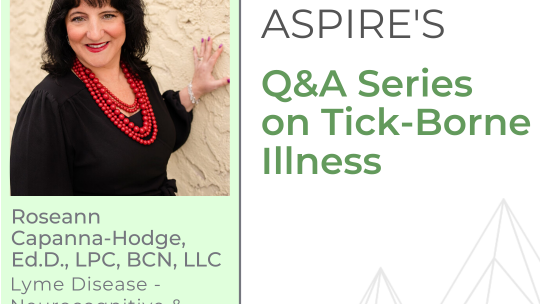
PANS & Lyme Disease – Dr. Delaney
Lyme disease, PANS, and the Columbia University Lyme & Tick-borne Research Center. Shannon L. Delaney, MD, Director, Child and Adolescent Evaluation, Lyme & Tick-borne Research Center, is a...

Lyme disease, PANS, and the Columbia University Lyme & Tick-borne Research Center. Shannon L. Delaney, MD, Director, Child and Adolescent Evaluation, Lyme & Tick-borne Research Center, is a...

May is Lyme Disease Awareness Month. ASPIRE will post several topics on Lyme Disease and Tick-Borne Illness. Check back here for...

Tick Testing and Disease Transmission Statistics Gabriella: Thank you to Dr. Rich for talking with ASPIRE today about Tick Report and his lab at U Mass. Dr. Rich and I...

Neurocognitive and neuropsychiatric symptoms associated with tick-borne disease. Gabriella: Dr. Roseann, thank you for joining ASPIRE to talk about neurocognitive and neuropsychiatric symptoms...

Every Friday during Lyme Disease Awareness Month, the Vector-Borne Disease Regional Centers of Excellence will give interactive presentations on their work for tickborne diseases such as; tick...

Tick Resources Tick Types, Tick Stages, Tick Diseases Tick Type & Stage Identification Chart List of Tick Borne Diseases Tick Table Tick Life Cycle CDC AKC Lyme Disease Rash Examples...
Anti-lysoganglioside and other anti-neuronal autoantibodies in post-treatment Lyme Disease and Erythema Migrans after repeat infection
Brian A.Fallon, BarbaraStrobino, SeanReim, JulieStoner, Madeleine W.Cunningham Brain, Behavior, & Immunity – Health, Volume 2, February 2020, 100015. https://doi.org/10.1016/j.bbih.2019.100015
This study examines molecular mimicry targeting neural tissue after Borrelia burgdorferi (Bb) infection. Patients with Lyme disease have a greater frequency of specific anti-neuronal autoantibodies and functional neuronal activation compared to community controls without a history of Lyme disease.
“Highlights

Polymicrobial nature of tick-borne diseases 430 of 678 (63%) positive for at least one human pathogen 57% Adults/27% Nymphs – Lyme 14% Adults/15% Nymphs -Babesia 14% Adults/2% Nymphs –...
Melanie Uhde, Alyssa Indart, Brian A Fallon, Gary P Wormser, Adriana R Marques, Suzanne D Vernon, Armin Alaedini, C-Reactive Protein Response in Patients With Post-Treatment Lyme Disease Symptoms Versus Those With Myalgic Encephalomyelitis/Chronic Fatigue Syndrome, Clinical Infectious Diseases, Volume 67, Issue 8, 15 October 2018, Pages 1309–1310, https://doi.org/10.1093/cid/ciy299
li Divan, Timothy Casselli, S. Anand Narayanan, Sanjib Mukherjee, David C. Zawieja, John A. Watt, Catherine A. Brissette, M. Karen Newell-Rogers, Published: May 3, 2018. https://doi.org/10.1371/journal.pone.0196893
Traditionally, mice haven’t shown neuroborreliosis, mirroring human symptoms, but this study achieved colonization of the central nervous system in mice. Using two strains of B. burgdorferi, researchers infected mice through the skin, consistently detecting spirochetes in the brain membranes 75 days post-infection. Live spirochetes were present, adhering to blood vessels, indicating long-term infection. The presence of CD3+ T cells suggested an immune response. These findings provide new avenues for studying neuroborreliosis and may offer insights into potential treatments for patients.

Presented by Southern Tier Lyme Support, Inc - Kenneth A. Bock, M.D., FAAFP, FAAFP, CNS, received his MD with Honor from the University of Rochester School of Medicine in 1979, and is the founder of...